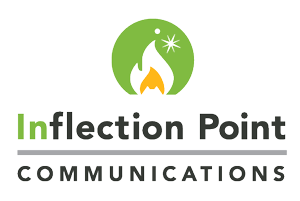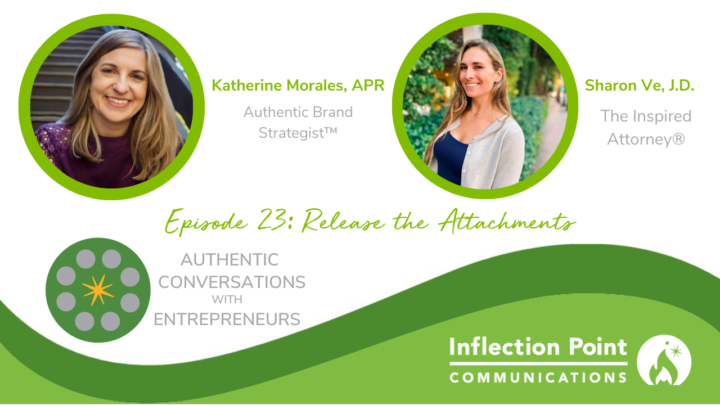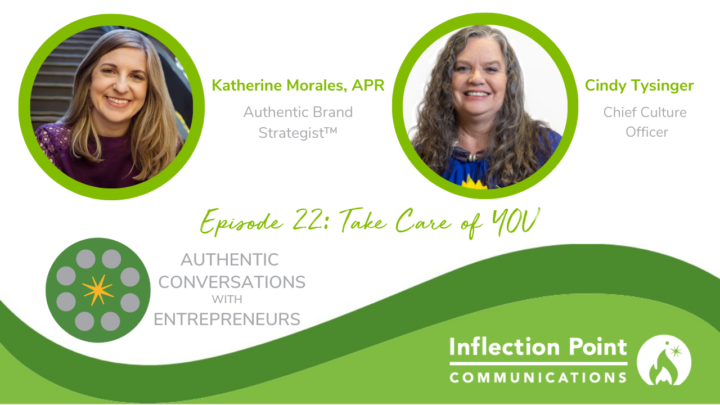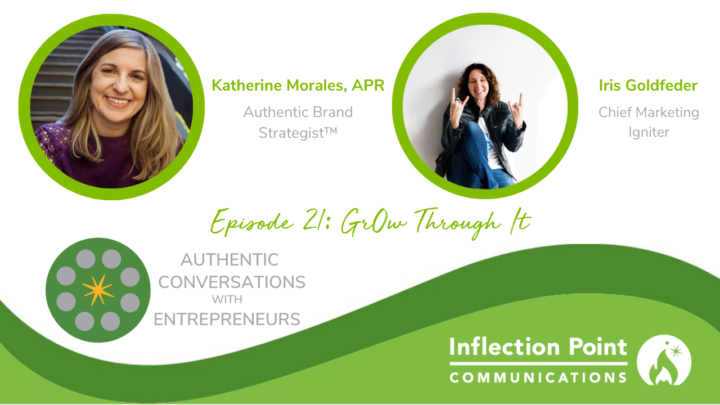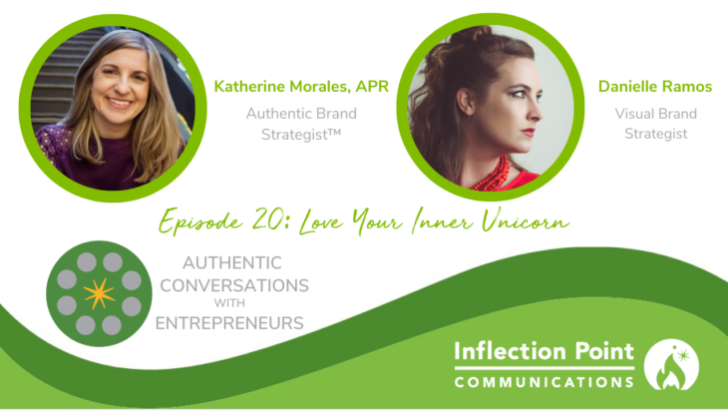In this episode of “Authentic Conversations with Entrepreneurs” I spoke with Julie Kessler, Chief Family Legacy Manager and Owner of Picture This Organized. Julie shared the story of founding and rebranding her business, as well as her personal journey of Celebrating in finding her voice and confidence as a business owner in a new/developing industry.
Katherine Morales: Hi, everyone. Thanks so much for tuning in to Authentic Conversations with Entrepreneurs. I am here with Julie Kessler all the way from Colorado. Julie is a Chief Family Legacy Manager and Owner of Picture This Organized. So I am so excited to have you here, Julie, but before we jump in, I just want to as always explain what the heck is an authentic conversation with an entrepreneur. I uniquely describe authenticity as the Good & Growing™, so this is all about the human stories. I’m so thankful that you’re here today, Julie, to share-
Julie Kessler: Thank you.
Katherine Morales: … the journey you’ve taken, but I think it’s incredible how you’re witnessing and your role, and we’ll get more into that, all of the stories of families, so what a beautiful business. So yeah, we’re going to jump into that. And today’s episode, episode 15, is on “Celebrating Your Stories.” So let’s begin there. You can say, hi, Julie, and just-
Julie Kessler: Hello.
Katherine Morales: I think just share, where did this start? What is your business? How did you get started in helping people to celebrate their stories?
Julie Kessler: So my business started with a personal project. My father was turning 80 and we wanted to come up with something that would honor his life. He was sort of incapacitated because he is a paraplegic, and I think he was finding that his life just lacked purpose. So my sisters and my mom and I came up with the idea of creating an album that was a little bit like, This Is Your Life TV show where you go back and look at your childhood and your family and all your interests.
And so basically that was the framework of his album and gathering the things that were important, the stories and the things that were important in his life. It was not just photos, but it was mementos, memorabilia. We did a little bit of interviewing with family and childhood friends. So-
Katherine Morales: Video?
Julie Kessler: Really it was just more of a letter because back then I didn’t really know how to do all of this kind of technology.
Katherine Morales: Yeah, nowadays, it might be different.
Julie Kessler: And in some cases, we had to have the children of his friends help with sending an email to respond. Oh, wow. So we just did what we could to gather what was important and put that all on the album for my dad.
Katherine Morales: And in doing so, you were celebrating his story, right?
Julie Kessler: Yes, yeah. And it became-
Katherine Morales: So how did that… Oh, go ahead. Sorry.
Julie Kessler: Go ahead. I was going to say it became something really important to him in the next two years of his life and something we could use for his memorial service to reveal the things about him that those that came to honor him learned about, because oftentimes in memorial services, you learn something more about the person that passed away than you already knew by those kinds of things.
Katherine Morales: Right.
Julie Kessler: Yeah.
Katherine Morales: Oh yeah. I just got goosebumps as you said that.
Julie Kessler: Yeah.
Katherine Morales: So how did that… I mean, thank you for sharing that, and it sounds like it was a family effort, but I am assuming that you kind of took more of a bigger role in the preparation of that. So how did that, I guess, evolve into, now I want to make this my business?
Julie Kessler: And I really didn’t know how the project was going to go. I just had a vision for how it would work or how it would look, and somehow it did. So then shortly after that, I found out about the possibility of becoming a residential organizer. And so for a year I did that and ran into clients that in the clutter in their households, they had photos that were not being honored. They were in a format they couldn’t really share. And so I started thinking about that, but then also realized this was the way I really wanted to connect with clients. So I rebranded and started a business of photo managing, help managing photo collections.
Katherine Morales: Mm-hmm. Hm. So was that an easy path? I know, Authentic… hence this show we get into the journey, right?
Julie Kessler: Yes. Oh my God.
Katherine Morales: Everyone thinks entrepreneurship is this fancy freedom and yeah, hustle, but it’s not a linear path. There are bumps in the road. So was it straightforward? What happened as you began that business and the rebranding?
Julie Kessler: Well, helping people with photo collections is a very new service. It’s a kind of an evolving industry, and so there isn’t really a template or a franchise to join, or at the time there wasn’t really training. So I was really figuring this out myself initially, and it was scary. It was scary to think about, “What do I charge for my services? What are my services?” Clients were hoping that I could be a trusted advisor, and I didn’t feel like one. That made me feel like an imposter, like I was pretending to know what I was doing.
And there were moments where I would literally pray, “Give me a sign that this is what I’m supposed to be doing, because this is really hard.” And I didn’t always get a sign of a solution, but I didn’t get a sign that I should stop, so I persevered.
Katherine Morales: Oh, there you go. It’s not a red light, so I’ll just keep going.
Julie Kessler: Doors aren’t closing.
Katherine Morales: I love the honesty of that. Yeah. Yeah. It’s interesting because I think this is what it takes in entrepreneurship, but in those moments of the imposter voice, how did you overcome it? What were some things that you did to just keep going?
JJulie Kessler: Well, at that time, I was also part of an organization that’s now called the Photo Managers, and I realized if I dug a little deeper into the resources that they offered that I could navigate this better. And there was also a business coach that was part of that group who decided to help people build their business, figure out pricing and processes, some basics about technology,
And so then I just didn’t feel as alone. I felt like I had somebody supporting me that I could reach out to when I needed answers. And I even used that as I was working with my clients. I would let them know that I didn’t know the answer to that problem, or I didn’t have a solution, but I had a list, some trusted advisors that I could reach out to, and they didn’t seem to hesitate, or that didn’t seem to be a barrier towards them considering my services.
Katherine Morales: Yeah. Well, that’s beautiful. And I think what you’re explaining is it’s when, I always talk about finding the harmony in business that there is kind of the inward world, and then there’s the outer world, and instead of having those kind of tug of war or pulling against one another, when you had that moment of, “Oh my gosh, I’m an imposter, I’m going to be found out,” which is natural in building your own path, what I love is that you leaned into the out and you found an organization. I love that. I think advisors are essential to finding that harmony, especially at certain junctures in your business.
Julie Kessler: Oh, yeah. Yeah.
Katherine Morales: I mean, I know we talked a little bit before this obviously, so one thing I want you to hint on, if you don’t mind is, I think there’s certain character traits that are true for entrepreneurs, especially I want to say, dare I say women entrepreneurs, but I have this perception maybe because I’m this way too, but we have a tendency to be a little bit perfectionist-y. So did you have that at any point? And because I think you said it simplistically, “Yeah, and then if I didn’t know the answer, I just said, ‘Well, I don’t know. I’m going to consult my advisors and I’ll get back to you,'” which is totally okay, but the journey to get to feeling inwardly that that’s okay.
Julie Kessler: Yeah, no, I grew up, I shared with you that I grew up feeling like I, because I was an introvert and quiet, I didn’t feel listened to, probably because there were family members that were more extroverts, so they wouldn’t share the microphone very readily. And so thinking about somebody listening to me didn’t feel authentic either.
So, the more I felt like I needed to perfect the technology as a natural perfectionist, I felt like, “Okay, this is a mess.” And that’s why I would pray for a sign that I needed to change. But then I also learned from my clients that I didn’t have to know everything, and it didn’t all have to be perfect.
I mean, sometimes their photo collections weren’t a perfect shot, and I would talk to them about how good for you that you captured the moment, and this tells a story. So this is a photo we can use. You don’t have to be a professional photographer for your stories or for your photos to be worthy of telling the story.
Katherine Morales: Yeah. That’s beautiful. And as you’re going to the picture, I can just share from my own experience that, it’s so interesting how a photo that I was like, “Oh man, I look so bad in that,” from give it 2, 3, 4 years, and then I’m looking at, I’m going, “Oh, this is actually a nice photo.”
Julie Kessler: Yeah. Not bad.
Katherine Morales: We see ourselves differently, right?
Julie Kessler: Oh, we do.
Katherine Morales: Give it some time.
Julie Kessler: We really do. And I often tell that to my clients. They’ll think that where their kids are now is the deciding factor to whether or not they’ll want to inherit their photos. And we’re all in a different place at certain moments. And if you’re preparing for their legacy for when they’re ready, that’s really the work that we’re trying to do for them.
Katherine Morales: Yeah, And I think, I want to come back to a word that you mentioned in your father’s story or your story of founding your business as well as working with your clients, and the word was honor. So I mean, that’s such a powerful, beautiful word. So how have you, obviously the topic is “Celebrating Your Stories,” so how do you work with your clients to help them not only celebrate, but honor their stories? Because every family has stories that maybe they don’t think they want to celebrate, but it’s important to honor them. How do you help them through that journey?
Julie Kessler: Well, I think we look at what are the sensitive moments, what are the things that are part of their story that maybe they want included in their collection, but they don’t necessarily want them highlighted?
My dad’s journey of having become a paraplegic was not going to be highlighted in his life story. There were photos of him in a wheelchair, but we didn’t really talk about that moment and his recovery. And sometimes that can be the case with our family’s photos. And now that we record everything on our phones, we record a bruise or an injury or something like that, there’s maybe a story of that of that moment, but does that really need to be part of telling your story? Most of the time not.
Katherine Morales: Call me crazy. I kind of like those moments. It’s interesting. My daughter just turned six, and I shared some pictures just yesterday celebrating that story.
But as she’s getting older now, like as you’re saying that, I go to this moment in that perfectionist phase when she was a baby, I started pureeing all of the vegetables. And I’m on, I am definitely not a mom blogger, but I’m on all the things like, “Which vegetable next?” And at one point I had done all the broccoli and all the peas and all that, and I got to parsnips.
Julie Kessler: Ooh, wow.
Katherine Morales: And I don’t even really eat parsnips. So what’s hilarious is we always recorded if, my husband was feeding her this time, but we always recorded the reaction to that food, which was great. And I absolutely, this would definitely be part of the package for me. There’s this video of her, my husband’s feeding her the parsnips, and I’m going like, “Oh, wow, that’s going to go.”
Julie Kessler: Yeah, yeah.
Katherine Morales: And she is probably eight months, and it is amazing how children are because she goes, “Ew,” and then she hits the table like this.
Julie Kessler: This is out of here.
Katherine Morales: And pushes away the spoon. It’s just the best and it’s not my most glorious moment of why did I feed my child something that I’m wouldn’t eat?
Julie Kessler: Yeah. Yeah.
Katherine Morales: But yeah, it’s just quintessential of learning to be a mom and learning.
Julie Kessler: Right. Right, oh, yeah. Good for you for capturing that.
Katherine Morales: Yeah, it just took me right to that moment.
Julie Kessler: Good for you for capturing that and then you can always decide what you want, as you look back, what you want to keep, right?
Katherine Morales: Well, she definitely finds it funny at the five and six-year-old that she’s become now. She finds it very funny to watch herself eat that.
Julie Kessler: Oh, good. Does she eat parsnips now?
Katherine Morales: Not so much. She loves carrots though.
Julie Kessler: There you go.
Katherine Morales: Parsnips, I guess cousin?
Julie Kessler: Yeah. I wouldn’t even know how to cook it.
Katherine Morales: Oh, I love and, sorry. I was just going to say, I think this is what, when we get curious, this is what happens. The stories start kind of bubbling up naturally. So yeah, I was going to say, I guess for our viewers or listeners who are sitting on that stack of just either the disparate all over the place photos or because sometimes they’re on the phone, and then the older ones for us, millennials are wherever they are. What tips would you give them? Where should they begin besides the call to you, of course?
Julie Kessler: Well that’s-
Katherine Morales: How can they start celebrating and honoring their stories?
Julie Kessler: They have to be organized. They have to know what’s important to them, know who all the players are, all the people in their family, but then know that there is a right way to do this and getting everything in one place is really important. Don’t have your collection scattered among multiple devices where it’s a separate piece of your collection on one site or another site, or one device, an old device, that it’s really important to get it all gathered together because then you can look at it with a better eye for what’s important.
Katherine Morales: Mm-hmm.
Julie Kessler: Just like when you’re organizing documents, you have to have all the documents in one place in order to know which ones are the right version. Right?
You might keep the wrong version of something that’s an old version and you want the new one.
Katherine Morales: Right. And is that digitizing all those old photos?
Julie Kessler: Yeah, definitely-
Katherine Morales: The hard copy photos?
Julie Kessler: Digitizing, getting everything in the same format, so that then the hard copies are now digital files. The digital images are merged in with those, but then organized in a way that’s usually chronological or by theme, and then you can really start to find the story-worthy photos from that.
Katherine Morales: I love that. That has a little ring to it. Story worthy.
Julie Kessler: Yeah. Yeah.
Katherine Morales: Very cool. And what’s interesting to me is, and I’d love your thoughts on this, but I think that in your own sharing of your story, I think it’s easy to get caught in the motions of life and or business, right?
Julie Kessler: Mm-hmm.
Katherine Morales: But what the business that you’re in, and I think even by doing this interview, honestly, Julie, it’s like when we recount and we share our story, we are celebrating it, right?
Julie Kessler: Yes. Yeah.
Katherine Morales: I just want to thank you for being willing to talk about you, the introvert and perfectionist, and these are the sides of us that maybe we’d like to forget or not put on the front stage, but I can’t tell you how many introverts there are and entrepreneurs that are introverts. It doesn’t mean you can’t be a business owner.
But what’s interesting is, and I was saying this to you before, we bring ourselves to our business, so something that was true for you as a child and maybe worked in a corporation or another business, when you become an entrepreneur, you find that you’re in a relationship with it again, because it always was there, but now it’s just you.
JJulie Kessler: Right.
Katherine Morales: So yeah.
Julie Kessler: You learn how to manage what seems like a weakness to being something that makes you actually relatable to your clients. And when you’re vulnerable with them about that, I’ve shared, I’m not natural with technology. That’s not a natural bent for me. I’ve learned to understand what’s important and then use the experts to make decisions.
And so they relax because they realize, “Okay.” They feel like they need to apologize for their inability to understand technology, and they appreciate that we can be the people they can lean on for that, and we can guide them through, help them with basics maybe that they need for using their phone or their camera, but after that they can lean on us.
Katherine Morales: Well and I mean technology moves so quickly, so I know that’s probably been a cornerstone to your business, but it sounds like your business has grown and you have the team, so yeah, who knows what the new technology will bring, but that’s for another episode, I’m sure.
Julie Kessler: Yes. Yeah. A whole technology conversation could be had. Yes.
Katherine Morales: Right. I literally was just on a AI ethics and, public relations and AI webinar the other day, so it is a hot topic. But yeah, I’m happy to have this authentic conversation-
Julie Kessler: Thank you.
Katherine Morales: … and certainly I think it will be the next chapter for your business perhaps. And since technology is a key part of it, but-
Julie Kessler: Oh, for sure.
Katherine Morales: I know obviously that people are curious where to find you, so I’m going to put that up.
Julie Kessler: Okay.
Katherine Morales: So you can find Julie at PictureThisOrganized.com. I love how that just naturally conveys me sitting at my busy desk, but the photos hidden in between. I just love the simplicity and just the vision that’s outlined in that. So-
Julie Kessler: Thank you. Yeah.
Katherine Morales: … beautiful name. And obviously you’re here on LinkedIn. Picture This Organized as well as Facebook and Instagram. And is there anything besides this that you’d like to share with our viewers? I know you shared, I love the tip, the simplicity of get them all in one place, but beyond that, is there another tool or anything that you can provide?
Julie Kessler: I guess I would just say that if anybody is looking for help in this way, that know that you need to find an expert that has a proven process, but that can also be customized to what you want, what your outcome is, so that you don’t feel cornered into something different than what you can handle. Right?
Because you want to get it in a better place, but you also need to know that you can maintain it, but that’s also something that we can do for you. And there are experts that can help stay in relationship with you and be part of your family through your photo collections as we make sure that everything gets honored and preserved.
Katherine Morales: I think one word that you had used when you were in the journey or prior to this interview, I mean you were in the journey of getting the skills and the technology, was that at one point it felt insurmountable to you.
And I would just say to our viewers, obviously you have to be in a point. For you, it was your father’s 80th birthday. So there is some sort of milestone or moment where you are wanting to honor this family member.
Julie Kessler: Yes.
Katherine Morales: So if you’re in that moment and you’re just trying to do it on an app and do it all yourself, and it’s feeling insurmountable, I’m just going to say, call Julie.
Julie Kessler: Yeah.
Katherine Morales: But I know you also have this free tool here. So what will they get with this, the 8 Ways To Tell Stories With Your Family Photos. Is this tips on which family photos they should get or can you give us a little preview of it?
Julie Kessler: It’s a little bit about finding the stories in the photos that you already have that tell a story and making sure you’re looking for story-worthy ones, but it’s also thinking in terms of how to take a photo that tells a story. So making sure that-
Katherine Morales: Ooh. I love that.
Julie Kessler: You’re catching people in a moment and not necessarily everything doesn’t have to be a posed group shot.
Katherine Morales: Because they posed. Yeah.
Julie Kessler: Because they don’t always tell the story like they do with people at a restaurant table or in the moment, and they don’t always have to be perfect.
Katherine Morales: I love this. Yeah, I’m going to be getting my copy because I think those are the two things to really consider. But I mean, beautiful business, beautiful story, Julie. Thank you so much. Yeah. I hope our viewers go to Bit.ly/FamilyPhotoStories to get that free tool that you have to offer.
And I just, yeah, I want to say thank you for being here, for doing this interview, this conversation and finding… I’d say my word for the year, I don’t know if you do that, but my word for the year is evolve. And I think that that’s what you’re naturally conveying in your journey of business, that you have…
Evolved isn’t about, I used it first in New Year’s when we do these resolutions. And I said-
Resolve is the root word there and that very word says there’s a problem. And so I said, “What are our New Year’s evolutions?” And that’s how I naturally got to, yes, it’s about there isn’t a problem. “Oh, I don’t know the technology,” or, “Oh, I’m building a business that doesn’t have a roadmap right now.” It’s committing to evolving and growing and progressing forward always, but doing it at your pace, so-
Julie Kessler: Right. Yeah.
Katherine Morales: I absolutely love sharing businesses that have built their own path and yeah, congratulations for the growth and how many years of business have you been?
Julie Kessler: Over 10.
Katherine Morales: Woohoo. Well, I don’t even need to highlight the stats on entrepreneurship. That is wonderful. Wonderful.
Julie Kessler: Thank you.
Katherine Morales: So thank you so-
Julie Kessler: Thank you so much for the opportunity to be part of this and tell my story. It’s always fun to look back and see where one started and where we are right now, so I appreciate the chance to do that, and I hope the listeners find this was useful.
Katherine Morales: Of course. Of course. And we’ll be sharing it afterwards. I’ll have it up on my website in a few days with the transcripts, so if you don’t have time to read or I mean view, you can read. And yeah, I will just say thank you for being here and a reminder for our viewers to tune in next month. Our next episode is April 20th at the same time, 1:30 p.m. ET. We’re talking to Melissa Unsell-Smith about “Pursue Passion.” It’s another key element of entrepreneurship.
Julie Kessler: Yes, for sure.
Katherine Morales: For now, we’ll leave you and thank you so much. Thank you, Julie.
Julie Kessler: Thank you. Thanks, everybody.
Katherine Morales: Go celebrate your families and your stories, everyone.
Julie Kessler: Okay. Thanks. Bye.
